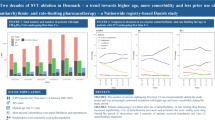Abstract
Purpose
Success rates for catheter ablation of supraventricular tachycardia (SVT) in the young exceed 90%. While studies have described reasons for initial ablation failure, less is known about outcomes of repeat ablation attempts. The purpose of this study was to report acute and mid-term success rates for second ablation attempts in young patients, as well as to analyze factors that may affect these outcomes.
Methods
Retrospective single-center study of all patients undergoing a second ablation attempt for WPW (Wolff-Parkinson-White) or SVT from 2008 to 2017. Inclusion criteria are all patients < 21 years old at the time of their first ablation who underwent a second ablation attempt. An intention to treat analysis was performed.
Results
Fifty-five patients met inclusion criteria, with a median age of 15 years (IQR 12–16). The most common arrhythmia mechanisms at repeat procedure were single accessory pathways (n = 32, 58%) and AVNRT (n = 14, 25%). Six patients (11%) were found to have a different SVT mechanism than at initial ablation. Acute success at repeat ablation was achieved in 48 patients (87%). At mid-term follow-up (10.5 months, IQR 0.6–25), four patients (8% of acute successes) experienced SVT recurrence. The overall success rate of repeat ablations, accounting for acute and mid-term failures, was 80%.
Conclusions
In this report of 55 young patients who underwent repeat ablation for WPW and/or SVT, acute and mid-term success rates were 87% and 80%, respectively. These data may help inform decision-making when caring for patients with persistent or recurrent SVT after an initial ablation attempt.



Similar content being viewed by others
References
Dick M, O’Connor BK, Serwer GA, LeRoy S, Armstrong B. Use of radiofrequency current to ablate accessory connections in children. Circulation. 1991;84(6):2318–24.
Kugler JD, Danford DA, Deal BJ, Gillette PC, Perry JC, Silka MJ, et al. Radiofrequency catheter ablation for tachyarrhythmias in children and adolescents. The pediatric electrophysiology society. N Engl J Med. 1994;330(21):1481–7.
Walsh EP, Saul JP, Hulse JE, Rhodes LA, Hordof AJ, Mayer JE, et al. Transcatheter ablation of ectopic atrial tachycardia in young patients using radiofrequency current. Circulation. 1992;86(4):1138–46.
Kugler JD, Danford DA, Houston K, Felix G. Radiofrequency catheter ablation for paroxysmal supraventricular tachycardia in children and adolescents without structural heart disease: pediatric EP society, radiofrequency catheter ablation registry. Am J Cardiol. 1997;80:1438–43.
Van Hare GF, Chiesa NA, Campbell RM, Kanter RJ, Cecchin F. Atrioventricular nodal reentrant tachycardia in children: effect of slow pathway ablation on fast pathway function. J Cardiovasc Electrophysiol. 2002;13:203–9.
Ceresnak SR, Dubin AM, Kim JJ, Valdes SO, Fishberger SB, Shetty I, et al. Success rates in pediatric WPW ablation are improved with 3-dimensional mapping systems compared with fluoroscopy alone: a multicenter study. J Cardiovasc Electrophysiol. 2015;26(4):412–6.
Tanel RE, Walsh EP, Triedman JK, Epstein MR, Bergau DM, Saul JP. Five-year experience with radiofrequency catheter ablation: implications for management of arrhythmias in pediatric and young adult patients. J Pediatr. 1997;131(6):878–87.
Buddhe S, Singh H, Du W, Karpawich PP. Radiofrequency and cryoablation therapies for supraventricular arrhythmias in the young: five-year review of efficacies. Pacing Clin Electrophysiol. 2012;35:711–7.
Van Hare GF, Javitz H, Carmelli D, Saul JP, Tanel RE, Fischbach PS, et al. Prospective assessment after pediatric cardiac ablation: recurrence at 1 year after initially successful ablation of supraventricular tachycardia. Heart Rhythm. 2004;1(2):188–96.
Sacher F, Wright M, Tedrow UB, O'Neill MD, Jais P, Hocini M, et al. Wolff-Parkinson-White ablation after a prior failure: a 7-year multicentre experience. Europace. 2010;12(6):835–41.
Bhat DP, Du W, Karpawich PP. Testing efficacy in determination of recurrent supraventricular tachycardia among subjectively symptomatic children following "successful" ablation. Pacing Clin Electrophysiol. 2014;37(8):1009–16.
Belhassen B, Rogowski O, Glick A, Viskin S, Ilan M, Rosso R, et al. Radiofrequency ablation of accessory pathways: a 14 year experience at the Tel Aviv medical center in 508 patients. Isr Med Assoc J. 2007;9:265–70.
Tuzcu V. Cryoablation of accessory pathways in children. Pacing Clin Electrophysiol. 2007;30(9):1129–35.
Atienza F, Arenal A, Torrecilla EG, García-Alberola A, Jiménez J, Ortiz M, et al. Acute and long-term outcome of transvenous cryoablation of midseptal and parahissian accessory pathways in patients at high risk of atrioventricular block during radiofrequency ablation. Am J Cardiol. 2004;93(10):1302–5.
Avari JN, Jay KS, Rhee EK. Experience and results during transition from radiofrequency ablation to cryoablation for treatment of pediatric atrioventricular nodal reentrant tachycardia. Pacing Clin Electrophysiol. 2008;31(4):454–60.
Ceresnak SR, Kahana M, Zucker HA, Mann G, Nappo L, Pass RH. Effects of ventilation and catheter position on catheter movement on the tricuspid annulus during ablation in children. Pacing Clin Electrophysiol. 2014;37(8):1051–7.
Janson CM, Ceresnak SR, Choi JM, Dubin AM, Motonaga KS, Mann GE, et al. A prospective assessment of optimal mechanical ventilation parameters for pediatric catheter ablation. Pediatr Cardiol. 2019;40(1):126–32.
Clark BC, Sumihara K, McCarter R, Berul CI, Moak JP. Getting to zero: impact of electroanatomical mapping on fluoroscopy use in pediatric catheter ablation. J Interv Card Electrophysiol. 2016;46(2):183–9.
Pass RH, Gates GG, Gellis LA, Nappo L, Ceresnak SR. Reducing patient radiation exposure during paediatric SVT ablations: use of CARTO® 3 in concert with "ALARA" principles profoundly lowers total dose. Cardiol Young. 2015;25(5):963–8.
Funding
This research did not receive any specific grant from funding agencies in the public, commercial, or not-for-profit sectors.
Author information
Authors and Affiliations
Corresponding author
Ethics declarations
Conflict of interest
The authors declare that they have no conflict of interest.
Additional information
Publisher’s note
Springer Nature remains neutral with regard to jurisdictional claims in published maps and institutional affiliations.
Rights and permissions
About this article
Cite this article
Rochelson, E., Clark, B.C., Janson, C.M. et al. “If at first you don’t succeed”: repeat ablations in young patients with supraventricular tachycardia. J Interv Card Electrophysiol 59, 423–429 (2020). https://doi.org/10.1007/s10840-019-00672-2
Received:
Accepted:
Published:
Issue Date:
DOI: https://doi.org/10.1007/s10840-019-00672-2




